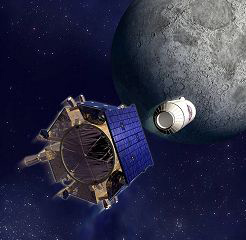 NASA has found a significant amount of water ice on the Moon!
NASA has found a significant amount of water ice on the Moon!
Holy Haleakala!
On October 9, the LCROSS spacecraft watched as a Centaur rocket booster slammed into the south pole of the Moon, hoping to determine if any water ice exists under the lunar surface. The idea is that over millions of years, comet impacts and other events have brought water to the Moon. Most of it goes away over time, but if any water happens to accumulate at the bottoms of craters at the poles, where the Sun never shines, it can stay put, frozen forever in shadow. By impacting a spacecraft into the Moon, it can eject the ice where it gets hit by raw sunlight. The water breaks down into hydrogen and hydroxyl molecules (OH-), which can be directly detected.
 The target crater, Cabeus, has a temperature on its floor of -230 Celsius, cold enough to store ice. The Centaur slammed into it at high speed, making a new crater about 20 meters across and splashing debris over an even bigger area. A plume went up and out of the crater, and it was that tower of ejected material that had the telltale signs of water. The infrared spectrometer on LCROSS definitely detected absorption lines from water, and the ultraviolet spectrometer saw it in emission. Not only that, the emission got stronger with time, which clinches the deal! That’s exactly what you expect by a plume containing water.
The target crater, Cabeus, has a temperature on its floor of -230 Celsius, cold enough to store ice. The Centaur slammed into it at high speed, making a new crater about 20 meters across and splashing debris over an even bigger area. A plume went up and out of the crater, and it was that tower of ejected material that had the telltale signs of water. The infrared spectrometer on LCROSS definitely detected absorption lines from water, and the ultraviolet spectrometer saw it in emission. Not only that, the emission got stronger with time, which clinches the deal! That’s exactly what you expect by a plume containing water.
Wow.
The amount of water they found in the plume was a couple of hundred kilograms in total, but that indicates there is a lot more still lying on the surface. They don’t know how much exactly just yet; NASA wanted to release this news as soon as they were sure they had definite results, but there is still much to do. Where did this water come from? How long has it been there? How accessible is it to future astronauts? These questions and more will, hopefully, be answered in the coming weeks and months as the data are analyzed more thoroughly. So stay tuned. There’s lots more good news to come!